Uncovering Norway: Descriptions of Four New Aphidiinae Species (Hymenoptera, Braconidae) with Identification Key and Notes on Phylogenetic Relationships of the Subgenus Fovephedrus Chen
Abstract
Simple Summary
Abstract
1. Introduction
2. Material and Methods
Sampling and Morphological Analysis
3. Results
3.1. New Species Descriptions
3.1.1. Aphidius norvegicus sp.n. Tomanović & Kocić (Figure 5)

3.1.2. Praon breviantennalis sp.n. Kocić & Tomanović (Figure 6)

3.1.3. Ephedrus gardenforsi sp. n. Kocić & Tomanović (Figure 7)
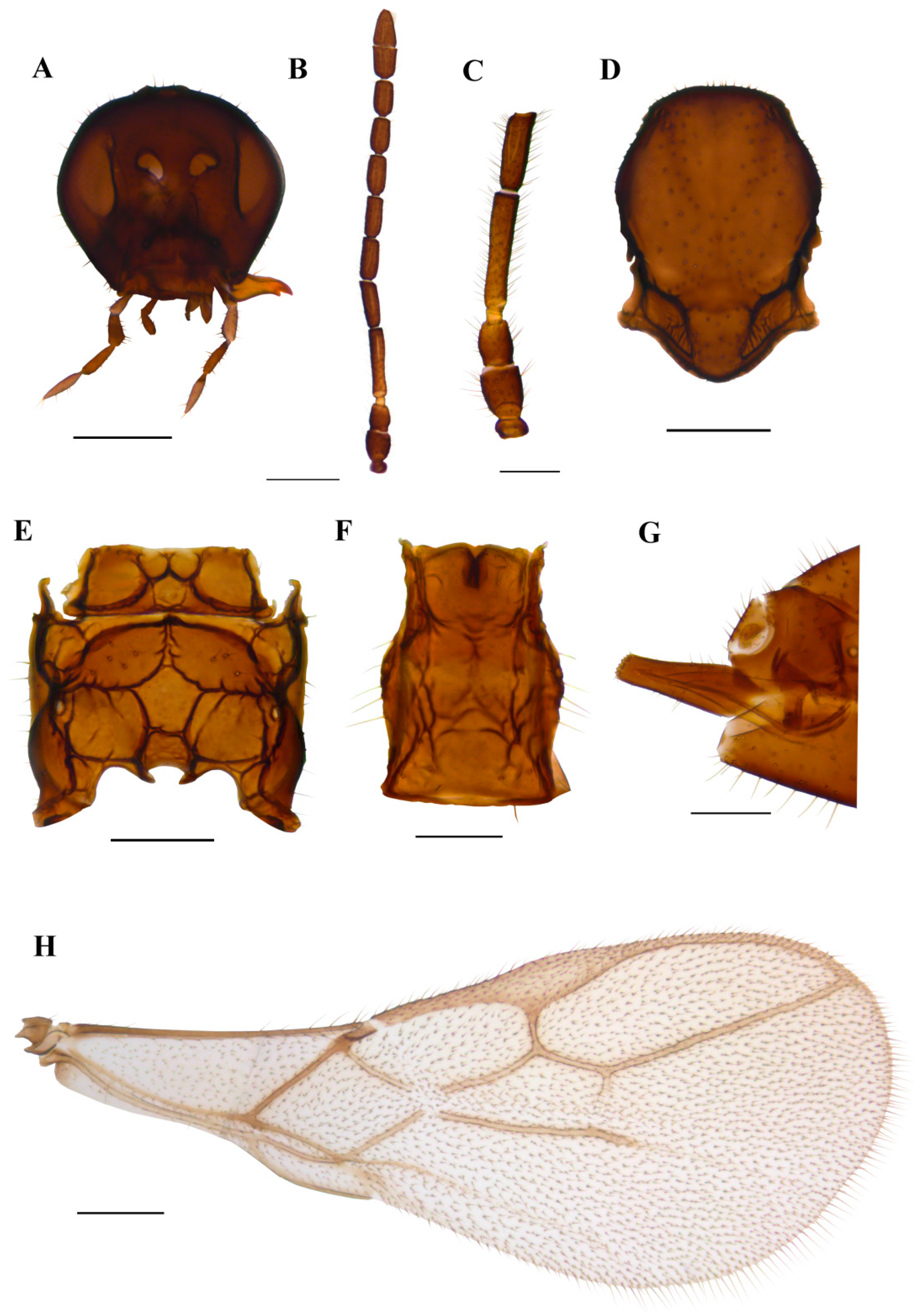
3.1.4. Ephedrus borealis sp.n. Kocić & Tomanović (Figure 8)
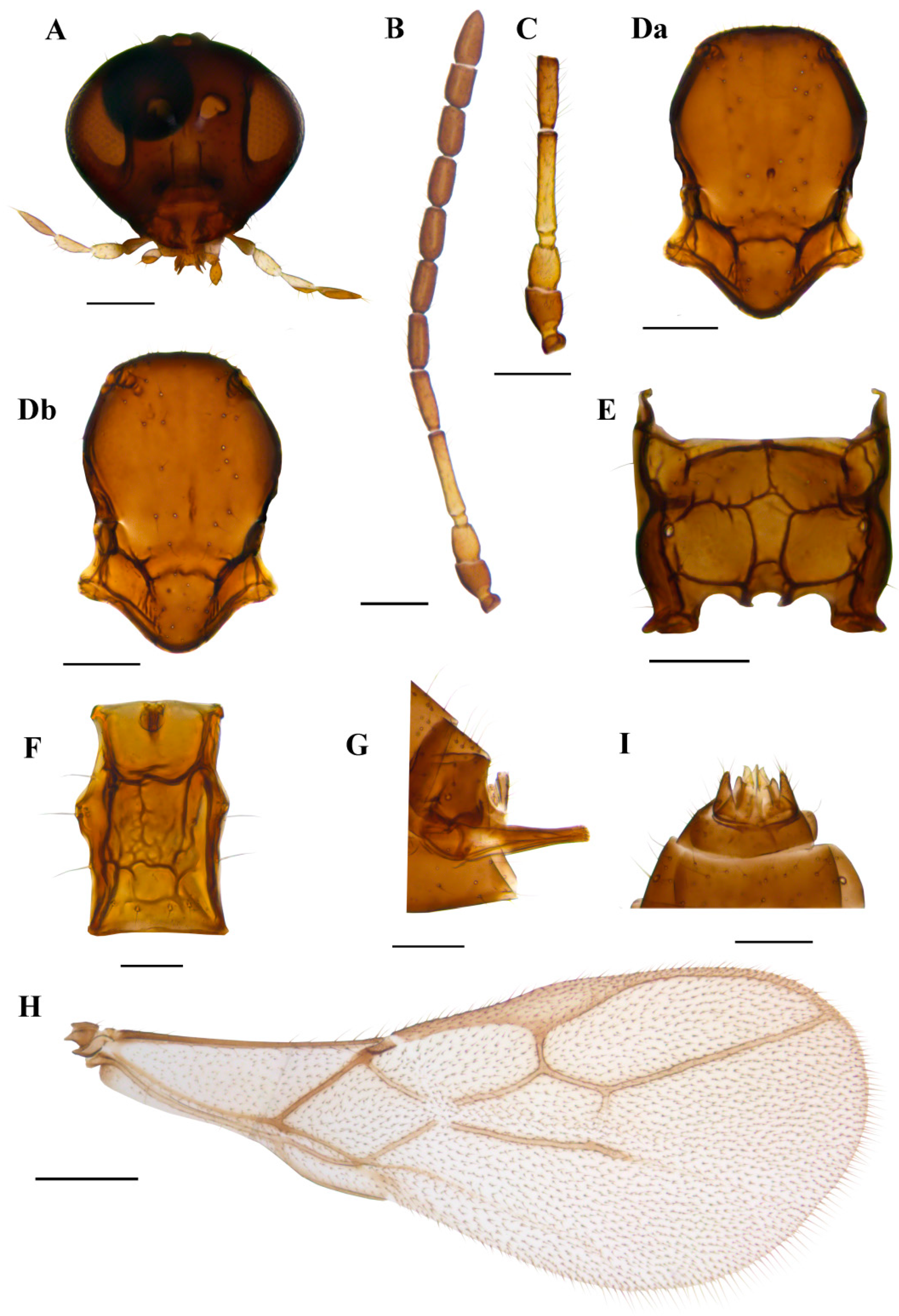
- Key for Identification of Female Parasitoids Belonging to Subgenus Fovephedrus (Ephedrus persicae Species Group)
- 1
- Number of antennomeres 12, central areola of propodeum not clearly defined......................................………………E. antennalis Tomanović
- –
- Number of antennomeres 11, central areola of propodeum clearly defined………………………………………………………………………...2
- 2
- F1 very long, 5.7–6.3 times as long as wide, narrow central propodeal areola, petiole elongated, 1.9–2.3 times as long as wide at spiracle level (Figure 8) …………………………………………………………………………………………......……….E. borealis sp.n. Kocić & Tomanović
- –
- F1 3.8–5.3 times as long as wide, wide central areola of propodeum, petiole subquadrate, 1.1–1.6 times as long as wide at spiracle level…………………………………………………………………………………………………………………………………………………………....3
- 3
- Mesoscutum with two foveal pits, F1 elongated, 5.0–5.3 times as long as wide.........……….....E. lonicerae Tomanović, Kavallieratos & Starý
- –
- Mesoscutum with one foveal pit, F1 3.8–4.9 times as long as wide …………………………………………………………………………………...4
- 4
- F1 uniformly brown, 3.8–4.2 times as long as wide………………………………………………………………………………..E. persicae Froggatt
- –
- F1 with the yellow ring at the base, or 1/2 to 2/3 yellow, 4.5–4.9 times as long as wide………………………………………………………….....5
- 5
- F1 with narrow yellow ring at the base, F1 subequal to F2 (1.2–1.3)…….…………………..…………………E. tamaricis Tomanović & Petrović
- –
- Approx. 1/2 to 2/3 of F1 yellow, F1 1.3–1.5 times longer than F2…………………………................………………………………………………...6
- 6
- Flagellomeres F8 and F9 well separated, ovipositor sheath elongated with subapical constriction……………….....E. chaitophori Gärdenfors
- –
- F8 and F9 not well separated, forming a club, ovipositor sheath without subapical constriction (Figure 7)..…………………………………………………………………………………………………......................E. gardenforsi sp.n. Kocić & Tomanović
4. Discussion
Author Contributions
Funding
Data Availability Statement
Acknowledgments
Conflicts of Interest
References
- Sánchez-Bayo, F.; Wyckhuys, K.A.G. Worldwide decline of the entomofauna: A review of its drivers. Biol. Conserv. 2019, 232, 8–27. [Google Scholar] [CrossRef]
- Hallmann, C.A.; Sorg, M.; Jongejans, E.; Siepel, H.; Hofland, N.; Schwan, H.; Stenmans, W.; Müller, A.; Sumser, H.; Hörren, T.; et al. More than 75 percent decline over 27 years in total flying insect biomass in protected areas. PLoS ONE 2017, 12, e0185809. [Google Scholar] [CrossRef]
- Petrović, A. Sizing the knowledge gap in taxonomy: The last dozen years of Aphidiinae research. Insects 2022, 13, 170. [Google Scholar] [CrossRef]
- The Norwegian Biodiversity Information Centre (NBIC). 2024. Available online: https://www2.artsdatabanken.no/ (accessed on 23 May 2024).
- SLU Swedish Species Information Centre, Swedish Taxonomical Database. Available online: https://namnochslaktskap.artfakta.se/ (accessed on 23 May 2024).
- Schneider, C.A.; Rasband, W.S.; Eliceiri, K.W. NIH Image to ImageJ: 25 years of image analysis. Nat. Methods 2012, 9, 671–675. [Google Scholar] [CrossRef] [PubMed]
- Sharkey, M.J.; Wharton, R.A. Morphology and terminology. In Manual of the New World Genera of the Family Braconidae; Wharton, R.A., Marsh, P.M., Sharkey, M.J., Eds.; International Society of Hymenopterists: Washington, DC, USA, 1997. [Google Scholar]
- Folmer, O.; Black, M.; Hoeh, W.; Lutz, R.; Vrijenhoek, R. DNA primers for amplification of mitochondrial cytochrome c oxidase subunit I from diverse metazoan invertebrates. Mol. Mar. Biol. Biotechnol. 1994, 3, 294–299. [Google Scholar] [PubMed]
- Hall, T.A. BioEdit: A user-friendly biological sequence alignment editor and analysis program for Windows 95/98/NT. Nucleic Acids Symp. Ser. 1999, 41, 95–98. [Google Scholar]
- Tamura, K.; Stecher, G.; Peterson, D.; Filipski, A. MEGA 6: Molecular evolutionary genetics analysis 864 version 6.0. Mol. Biol. Evol. 2013, 30, 2725–2729. [Google Scholar] [CrossRef]
- Kimura, M.A. Simple Method for Estimating Evolutionary Rates of Base Substitutions through Comparative Studies of Nucleotide Sequences. J. Mol. Evol. 1980, 16, 111–120. [Google Scholar] [CrossRef]
- Tamura, K.; Nei, M. Estimation of the Number of Nucleotide Substitutions in the Control Region of Mitochondrial DNA in Humans and Chimpanzees. Mol. Biol. Evol. 1993, 10, 512–526. [Google Scholar] [CrossRef]
- Hofsvang, T.; Hagvar, E.B. Primary parasitoids (Hym., Aphidiidae) and hyperparasitoids on aphids from Norway. Fauna Nor. Ser. B 1983, 30, 60–62. [Google Scholar]
- Riedel, M.; Hansen, L.O.; Berg, O. Braconidae (Hymenoptera) of Norway, Part 1. Nor. J. Entomol. 2002, 49, 97–108. [Google Scholar]
- Westrum, K.; Klingen, I.; Hofsvang, T.; Hågvar, E.B. Checklist of primary parasitoids and hyperparasitoids (Hymenoptera, Apocrita) on aphids (Hemiptera, Aphididae) from Norway. Nor. J. Entomol. 2010, 57, 142–153. [Google Scholar]
- Riedel, M.; Hansen, L.O. Braconidae (Hymenoptera) of Norway, Part II. Nor. J. Entomol. 2014, 61, 147–159. [Google Scholar]
- Yu, D.; van Achterberg, C.; Horstmann, K. Taxapad 2016. Ichneumonoidea 2015 (Biological and Taxonomical Information), Taxapad Interactive Catalogue Database on Flashdrive (Nepean). 2016. Available online: www.taxapad.com (accessed on 6 February 2024).
- Tomanović, Ž.; Žikić, V.; Petrović, A. Fauna of parasitoid wasps (Hymenoptera, Braconidae, Aphidiinae) of Serbia; Monographs, Book 15; Serbian Academy of Sciences and Arts: Beograd, Serbia, 2021; 262p. (In Serbian) [Google Scholar]
- Tomanović, Ž.; Žikić, V.; Petrović, A. Aphidius Nees (Hymenoptera, Braconidae, Aphidiinae) in Serbia: Key to species identification including parasitoid–aphid host list. Acta Entomol. Serbica 2023, 28, 61–76. [Google Scholar]
- Kavallieratos, N.G.; Tomanović, Ž.; Starý, P.; Athanassiou, C.G.; Fasseas, C.; Petrović, O.; Ljubiša, Ž. Stanisavljević, Maria Anagnou Veroniki, Praon Haliday (Hymenoptera: Braconidae: Aphidiinae) of Southeastern Europe: Key, host range and phylogenetic relationships. Zool. Anz. 2005, 243, 181–209. [Google Scholar] [CrossRef]
- Gärdenfors, U. Taxonomic and biological revision of Paleartcic Ephedrus Haliday (Hymenoptera, Braconidae, Aphidiinae). Entomol. Scand. Suppl. 1986, 27, 1–95. [Google Scholar]
- Žikić, V.; Tomanović, Ž.; Ivanović, A.; Kavallieratos, N.G.; Starý, P.; Stanisavljević, L.j.; Rakhshani, E. Morphological characterization of Ephedrus persicae biotypes (Hymenoptera: Braconidae: Aphidiinae) in the Palaearctic. Ann. Entomol. Soc. Am. 2009, 102, 1–11. [Google Scholar] [CrossRef]
- Petrović, A.; Kocić, K.; Kos, K.; Plećaš, M.; Žikić, V.; Kavallieratos, N.G.; Tomanović, Ž. High genetic diversity and a new cryptic species within the Ephedrus persicae species group (Hymenoptera: Braconidae: Aphidiinae). Biologia 2016, 71, 1386–1394. [Google Scholar] [CrossRef]
- Tomanović, Ž.; Petrović, A.; Kocić, K.; Čkrkić, J.; Žikić, V. Two new morphologically interesting species of the genus Ephedrus Haliday (Hymenoptera, Braconidae, Aphidiinae). J. Hymenopt. Res. 2020, 77, 167–174. [Google Scholar] [CrossRef]
- Kocić, K.; Petrović, A.; Čkrkić, J.; Mitrović, M.; Tomanović, Ž. Phylogenetic relationships and subgeneric classification of European Ephedrus species (Hymenoptera, Braconidae, Aphidiinae). ZooKeys 2019, 878, 1–22. [Google Scholar] [CrossRef]
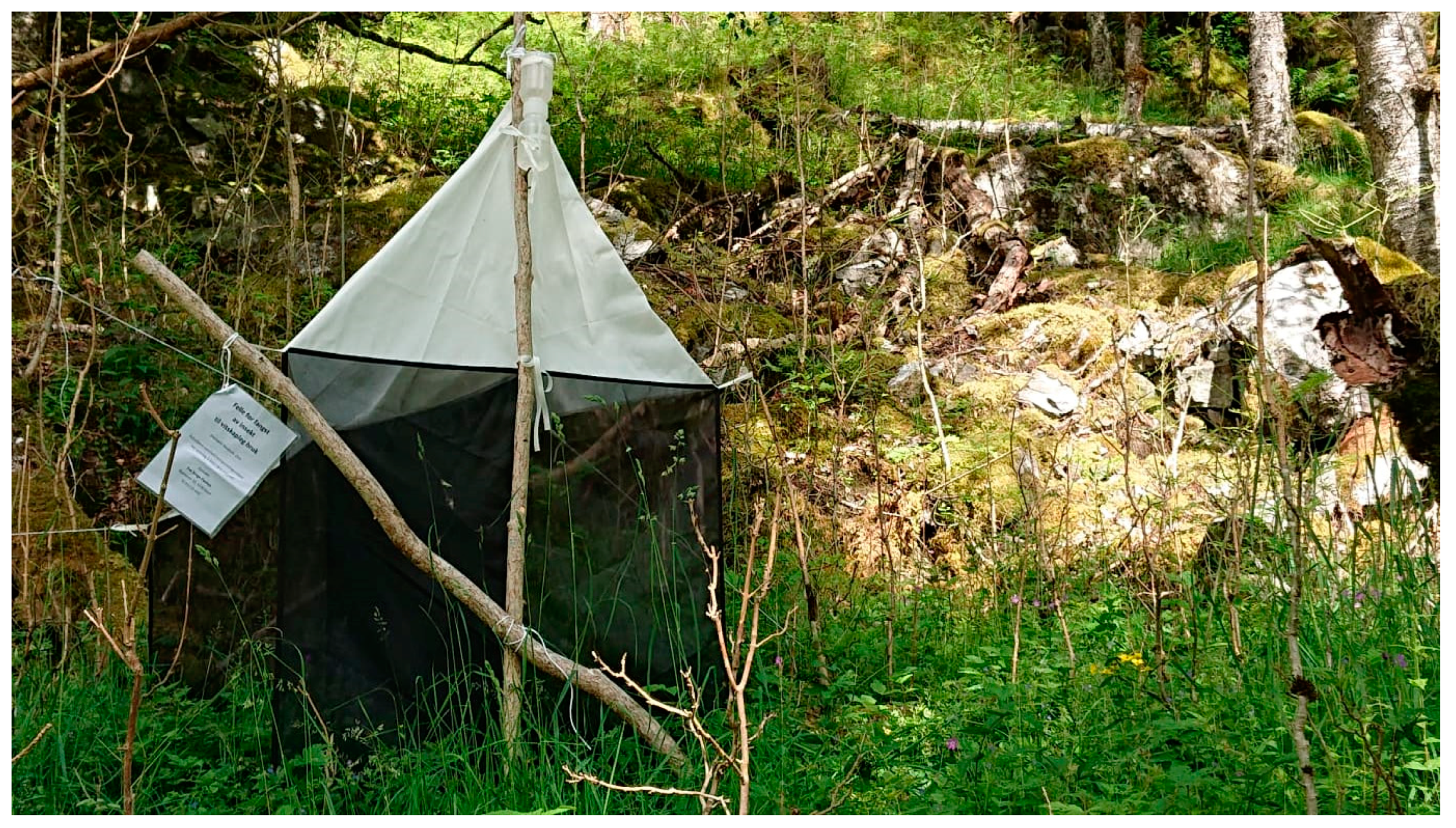
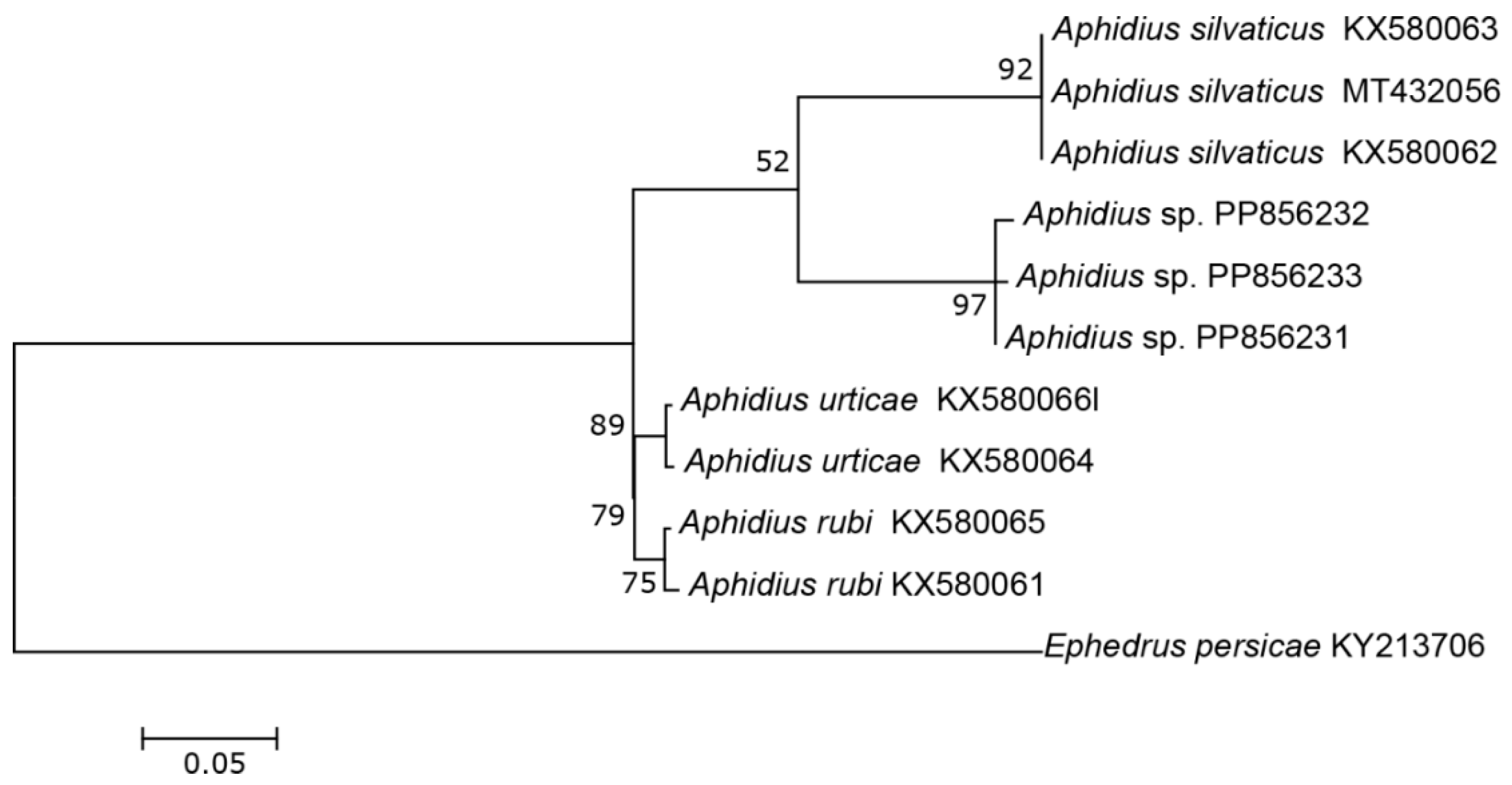

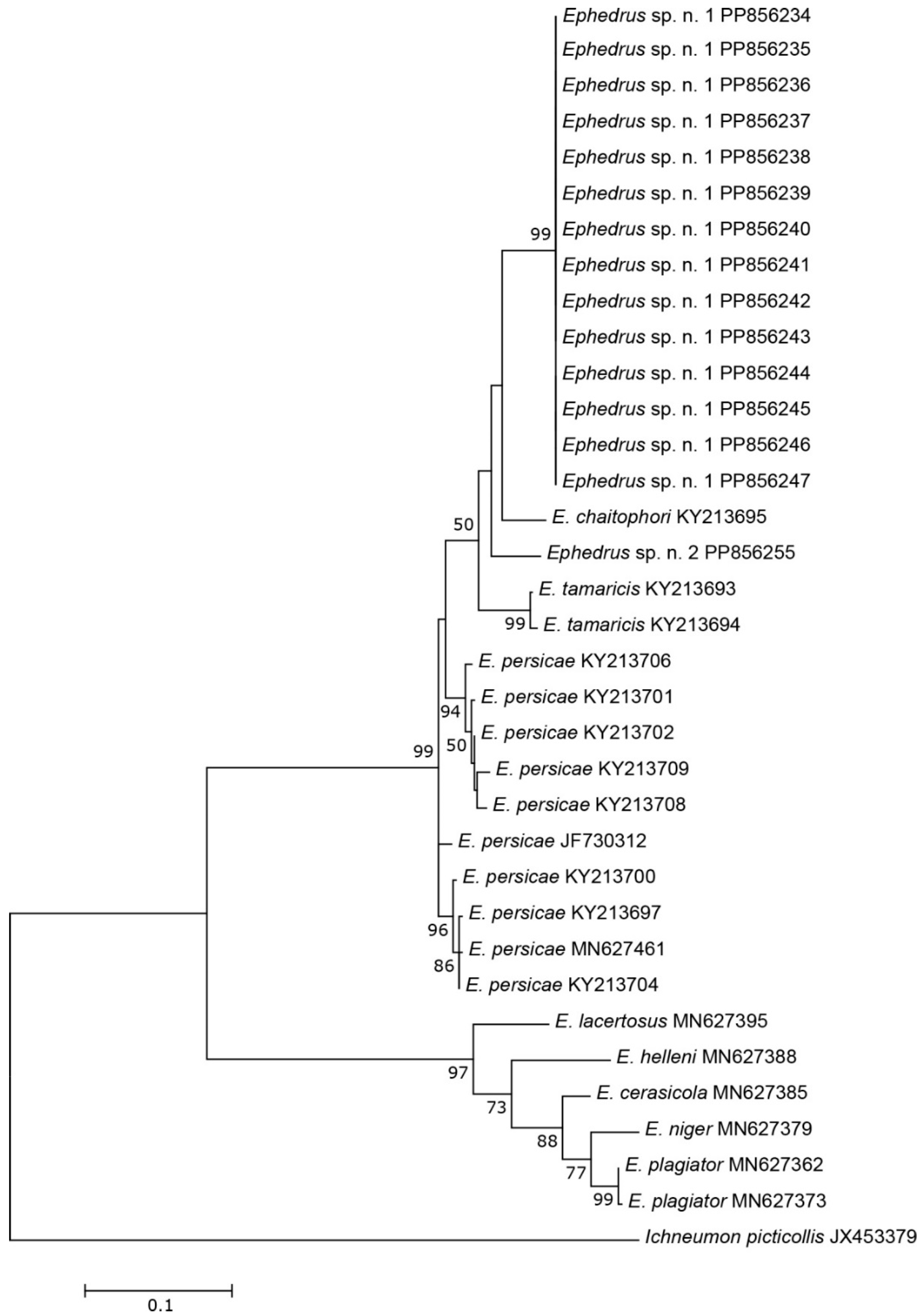
| Locality | Sampling Period | GPS Coordinates |
|---|---|---|
| Sola, Forus, Røynebergsletta | 29.06.2021–16.07.2021 | 58.90017 N, 5.68956 E |
| Sola, Forus, Røynebergsletta | 15.06.2021–29.06.2021 | 58.90041 N, 5.68971 E |
| Svanholmen | 15.08.2021–31.08.2021 | 58.88878 N, 5.71121 E |
| Suldal, Vårvik | 27.06.2021–03.08.2021 | 59.54282 N, 6.64587 E |
| Sandnes, Forus | 01.06.2022–15.06.2022 | 58.88880 N, 5.70937 E |
| Hå, Brusand | 31.08.2020–17.09.2020 | 58.53837 N, 5.74777 E |
| Time, Linemyra | 31.08.2021–30.09.2021 | 58.71556 N, 5.63867 E |
| Time, Linemyra | 01.08.2021–30.08.2021 | 58.71556 N, 5.63867 E |
| Time, Linemyra | 29.06.2021–20.07.2021 | 58.71556 N, 5.63867 E |
| Time, Linemyra | 21.07.2021–31.07.2021 | 58.71556 N, 5.63867 E |
| Time, Linemyra | 01.06.2021–29.06.2021 | 58.71556 N, 5.63867 E |
Disclaimer/Publisher’s Note: The statements, opinions and data contained in all publications are solely those of the individual author(s) and contributor(s) and not of MDPI and/or the editor(s). MDPI and/or the editor(s) disclaim responsibility for any injury to people or property resulting from any ideas, methods, instructions or products referred to in the content. |
© 2024 by the authors. Licensee MDPI, Basel, Switzerland. This article is an open access article distributed under the terms and conditions of the Creative Commons Attribution (CC BY) license (https://creativecommons.org/licenses/by/4.0/).
Share and Cite
Kocić, K.; Mjǿs, A.T.; Čkrkić, J.; Petrović, A.; Popović, N.; Paulsen, E.S.; Tomanović, Ž. Uncovering Norway: Descriptions of Four New Aphidiinae Species (Hymenoptera, Braconidae) with Identification Key and Notes on Phylogenetic Relationships of the Subgenus Fovephedrus Chen. Insects 2024, 15, 518. https://doi.org/10.3390/insects15070518
Kocić K, Mjǿs AT, Čkrkić J, Petrović A, Popović N, Paulsen ES, Tomanović Ž. Uncovering Norway: Descriptions of Four New Aphidiinae Species (Hymenoptera, Braconidae) with Identification Key and Notes on Phylogenetic Relationships of the Subgenus Fovephedrus Chen. Insects. 2024; 15(7):518. https://doi.org/10.3390/insects15070518
Chicago/Turabian StyleKocić, Korana, Alf Tore Mjǿs, Jelisaveta Čkrkić, Andjeljko Petrović, Nemanja Popović, Eva Songe Paulsen, and Željko Tomanović. 2024. "Uncovering Norway: Descriptions of Four New Aphidiinae Species (Hymenoptera, Braconidae) with Identification Key and Notes on Phylogenetic Relationships of the Subgenus Fovephedrus Chen" Insects 15, no. 7: 518. https://doi.org/10.3390/insects15070518
APA StyleKocić, K., Mjǿs, A. T., Čkrkić, J., Petrović, A., Popović, N., Paulsen, E. S., & Tomanović, Ž. (2024). Uncovering Norway: Descriptions of Four New Aphidiinae Species (Hymenoptera, Braconidae) with Identification Key and Notes on Phylogenetic Relationships of the Subgenus Fovephedrus Chen. Insects, 15(7), 518. https://doi.org/10.3390/insects15070518







